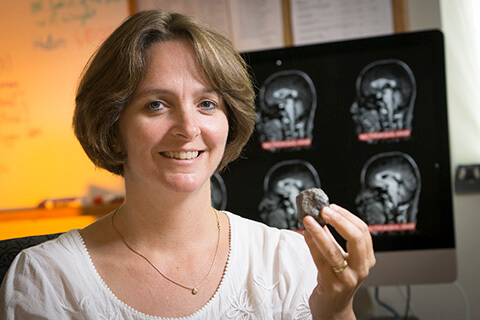Purdue Profiles: Ulrike Dydak
December 1, 2015
 |
|
Ulrike Dydak, associate professor of health sciences. (Photo by Vince Walter) |
Ulrike Dydak, associate professor of health sciences, recently led a group of 21 scientists across campus to acquire a $2 million National Institutes of Health grant to bring an MRI machine to the West Lafayette campus for life sciences research.
Dydak, who specializes in medical imaging of neurodegenerative diseases, needed access to a state-of-the-art MRI scanner to continue her research on manganese toxicity in occupational settings. She also realized that many of her colleagues could expand their research potential with access to an on-campus machine. The Siemens MAGNETOM Prisma 3T MRI is expected to be in use in 2016, and it will be utilized by faculty members from the College of Health and Human Sciences, Engineering, Science and Veterinary Medicine, as well as the Purdue Center for Cancer Research.
Dydak, who is in Purdue's School of Health Sciences, also is an adjunct associate professor of radiology and imaging sciences at the Indiana University School of Medicine. Her research focuses on better understanding the neural system in movement disorders and the mechanism of manganese toxicity, which has similarities to Parkinson's disease.
Can you talk about the significance of a dedicated MRI machine for the life sciences at Purdue?
An MRI scanner is a requirement to do my research, and that meant traveling off campus to use a machine and working around established hours. When the College of Health and Human Sciences formed in 2010, I realized just how many faculty needed access to an MRI for human studies. We had a great opportunity with the new college, Dean Christine Ladisch's excitement, and everyone working together to make this happen. It's already an asset to help with faculty hiring.
With a background in physics, what inspired you to focus on MRI technology and manganese toxicity?
I always wanted to combine medicine with physics, and discovering the opportunities that MRI technology gives us to study the brain and the brain function was exciting to me. Back as a doctoral student at the Swiss Federal Institute of Technology in Zürich, Switzerland, it was literally a poster on a professor's office door that caught my attention. It was a detailed, colorful scan of the brain. I knocked on the door, and said, "I would like to learn more about this technology – can I do my PhD with you," and that is what happened.
When I came to Purdue in 2007, I was the only person doing brain imaging and working with MRI technology in a very interdisciplinary department. I have lots of toxicology colleagues, and my department head, Wei Zheng, was highly involved in studies of manganese exposure with workers in China. So we talked about the possibilities to measure manganese levels in the brain with MRI. In 2008, we went to China to study smelters who had high exposure to manganese. During the scans, I didn't know who was a smelter or who was a control group member. But, I could see the brains of these smelter workers literally lighting up with the deposits of manganese and we found significantly altered brain chemistry in these otherwise healthy young workers.
It was an interesting application because you can directly try to correlate any neurocognitive effects, including motor dysfunction, to information obtained from imaging the brain. The initial findings of this pilot data were so drastic for such a small sample size that I wanted to know more about it.
How have your research outcomes made a difference?
It's always nice to see if there is a direct outcome of your research, and with our study on American welders we find effects in standard, typical exposure levels in the United States. Now we are looking at possible reversal of effects when the work environment is changed, such as installing ventilation systems. Our study also resulted in a behavior change with the welders; just by inviting them to participate in the study every two years, they started using respirators on a volunteer basis.
Writer: Amy Patterson Neubert, 765-494-9723, apatterson@purdue.edu

